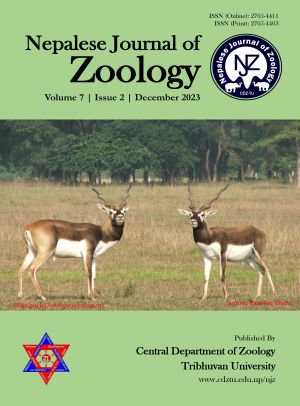Grouping dynamics of the northernmost population of blackbuck (Antilope cervicapra) in Krishnasaar Conservation Area, Nepal
DOI:
https://doi.org/10.3126/njz.v7i2.60806Keywords:
Anthropogenic disturbance, Blackbuck, Group size, Herding behaviour, Scan samplingAbstract
Blackbuck, Antilope cervicapra, are group-living grazers found in a wide range of habitats, from dry grasslands to open forests. Krishnasaar Conservation Area (KrCA) in Bardia, Nepal is home to the northernmost population of blackbuck. This population lives in close proximity to humans. As a population in an extreme of the species’ range and experiencing direct and indirect human influences, KrCA is suitable to study less explored facets of herbivore ecology and behavior. One such less explored behavior of herbivores is their grouping (herding) behavior. Grouping is commonly seen as an anti-predator response and could also be used in the context of anthropogenic threat. In this study we investigated herding behavior of blackbuck and ecological and anthropogenic factors that might influence the herding. To record the grouping behavior of blackbuck in the different habitat types, we used scan sampling methods for groups. A group was defined by including all individuals that are within 50 m of another individual. The influence of ecological and anthropogenic factors on herding pattern was assessed through simple regression modelling. We scanned animals for 89 hours and each hour had seven observations. The mean group size was 20.56 ±1.97 (mean ± SE). More than two-thirds of animals observed were female. We found larger herd sizes in the morning compared with herd sizes in the afternoon and evening. Our observations also showed that mixed herds were significantly larger in size than male-only, and female-only herds in both core and settlement zones. Our modelling of covariates predicted group type to be the single most influential factor influencing herd size. As herding behavior of animals reflect associated risk and resource factors, the finding of this work can be helpful in managing this isolated threatened population of blackbuck.
Downloads
Downloads
Published
How to Cite
Issue
Section
License

This work is licensed under a Creative Commons Attribution-NonCommercial 4.0 International License.
This license enables reusers to distribute, remix, adapt, and build upon the material in any medium or format for noncommercial purposes only, and only so long as attribution is given to the creator.

